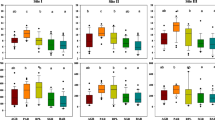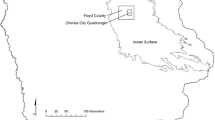Abstract
The main objective of this study was to characterize variation in soil chemical properties with length of urbanization period and distance to roads. Urban boundaries from 1920’s (old), 1960’s (middle) and 2000’s (new) were identified for three cities in northeast Ohio: Massillon, Wooster and Canton. Within each identified historic boundary, soil samples were collected from two road-side and two interior lawns in one public school site in each city. Thus, there were three urban age and two distance-to-roads classes. Soil particle composition and basic chemical properties including pH, available phosphorus (P), exchangeable potassium (K), calcium (Ca), magnesium (Mg), cation exchange capacity (CEC), nitrate, total carbon (C), total nitrogen (N), and soil organic matter (SOM) were measured. Two notable spatio-temporal patterns appeared repeatedly in the data set. First, total C, total N and SOM were higher in the soils of old (>50 years) urban sites than of newly developed sites. Similar, but not always significant, trends in soil pH, and exchangeable Ca were also observed. Second, road-side soils had higher pH, Ca, total C and N than interior sites regardless of urban age. These data indicate that key soil chemical properties can vary in predictable ways with urban age and distance-to-roads classes. Such variations in key soil chemical properties may influence or reflect soil biota and biogeochemical processes in urban soils.


Similar content being viewed by others
References
Association of Analytical Communities Official Methods of Analysis (2002) Method 990.03. Protein (crude) in Animal Feed Combustion Method (Dumas method). 17th edition
Beyer L, Blume HP, Elsner DC, Willnow A (1995) Soil organic-matter composition and microbial activity in urban soils. Sci Total Environ 168(3):267–278
Beyer L, Kahle P, Kretschmer H, Wu QL (2001) Soil organic matter composition of man-impacted urban sites in North Germany. J Plant Nutr Soil Sci 164(4):359–364
Boerner REJ, Scherzer AJ, Brinkman JA (1998) Spatial patterns of inorganic N, P availability, and organic C in relation to soil disturbance: a chronosequence analysis. Appl Soil Ecol 7(2):159–177
Carreiro MM, Howe K, Parkhurst DF, Pouyat RV (1999) Variation in quality and decomposability of red oak leaf litter along an urban-rural gradient. Biol Fertil Soils 30(3):258–268
Carreiro MM, Pouyat RV, Tripler C (2009) Nitrogen and carbon cycling in forests along urban-rural gradients in two cities. In: McDonnell MJ, Hahs A, Breuste J (eds) Ecology of cities and towns: a comparative approach. Cambridge University Press, Cambridge, pp 308–328
Combs SM, Nathan MV (1998) Soil organic matter. In: Recommended chemical soil test procedures for the North Central Region. NCR Publication No. 221. Missouri Agricultural Experiment Station, Columbia, MO, USA, pp 53–58
Craul PJ (1992) Urban soil in landscape design. Wiley, New York
El-Hasan T, Batarseh M, Al-Omari H, Ziadat A, El-Alali A, Al-Naser F, Berdanier BW, Jiries A (2006) The distribution of heavy metals in urban street dusts of Karak city, Jordan. Soil Sediment Contam 15(4):357–365
Ellis EC, Ramankutty N (2008) Putting people in the map: anthropogenic biomes of the world. Front Ecol Environ 6(8):439–447
Gelderman RH, Beegle D (1998) Nitrate-Nitrogen. In: Recommended chemical soil test procedures for the North Central Region. NCR Publication No. 221. Missouri Agricultural Experiment Station. Columbia, MO, USA, pp 17–18
Guan DS, Peart MR (2006) Heavy metal concentrations in plants and soils at roadside locations and parks of urban Guangzhou. J Environ Sci (China) 18(3):495–502
He Y, Zhang GL (2009) Historical record of black carbon in urban soils and its environmental implications. Environ Pollut 157(10):2684–2688
International Standard, ISO 10694 (1995) (E) Soil quality—Determination of organic and total carbon after dry combustion (elementary analysis). International Organization for Standardization. Geneva, Switzerland
Jim CY (1998) Physical and chemical properties of a Hong Kong roadside soil in relation to urban tree growth. Urban Ecosyst 2:171–181
Kalnay E, Cai M (2003) Impact of urbanization and land-use change on climate. Nature 423(6939):528–531
Kaye JP, McCulley RL, Burke IC (2005) Carbon fluxes, nitrogen cycling, and soil microbial communities in adjacent urban, native and agricultural ecosystems. Glob Change Biol 11(4):575–587
Kern JS, Johnson MG (1993) Conservation tillage impacts on national soil and atmospheric carbon levels. Soil Sci Soc Am J 57(1):200–210
Kettler TA, Doran JW, Gilbert TL (2001) Simplified method for soil particle-size determination to accompany soil-quality analyses. Soil Sci Soc Am J 65(3):849–852
Kuo S (1996) Phosphorus. In: Methods of soil analysis, Part 3—Chemical methods. Soil Science Society of America, Madison, WI, USA, pp 894–895
Lohse KA, Hope D, Sponseller R, Allen JO, Grimm NB (2008) Atmospheric deposition of carbon and nutrients across an arid metropolitan area. Sci Total Environ 402(1):95–105
Lorenz K, Kandeler E (2005) Biochemical characterization of urban soil profiles from Stuttgart, Germany. Soil Biol Biochem 37(7):1373–1385
Lorenz K, Preston CM, Kandeler E (2006) Soil organic matter in urban soils: estimation of elemental carbon by thermal oxidation and characterization of organic matter by solid-state C-13 nuclear magnetic resonance (NMR) spectroscopy. Geoderma 130(3–4):312–323
Manta DS, Angelone M, Bellanca A, Neri R, Sprovieri M (2002) Heavy metals in urban soils: a case study from the city of Palermo (Sicily), Italy. Sci Total Environ 300(1–3):229–243
McDonnell MJ, Pickett STA (1990) Ecosystem structure and function along urban-rural gradients: an unexploited opportunity for ecology. Ecology 71(4):1232–1237
McDonnell MJ, Pickett STA, Groffman P, Bohlen P, Pouyat RV, Zipperer WC, Parmelee RW, Carreiro MM, Medley K (1997) Ecosystem processes along an urban-to-rural gradient. Urban Ecosyst 1(1):21–36
Oke TR (1973) City size and urban heat island. Atmos Environ 7(8):769–779
Oke TR (1982) The energetic basis of the urban heat-island. Q J R Meteorol Soc 108(455):1–24
Ohio Web Library (2007) Sanborn fire insurance maps. Available at http://dmc.ohiolink.edu.proxy.oplin.org/oplinmap.htm. Accessed June 2007
Pagotto C, Remy N, Legret M, Le Cloirec P (2001) Heavy metal pollution of road dust and roadside soil near a major rural highway. Environ Technol 22(3):307–319
Pouyat RV, McDonnell MJ, Pickett STA (1995) Soil characteristics of oak stands along an urban-rural land-use gradient. J Environ Qual 24(3):516–526
Pouyat RV, Groffman P, Yesilonis I, Hernandez L (2002) Soil carbon pools and fluxes in urban ecosystems. Environ Pollut 116(Supple 1):S107–S118
Pouyat RV, Yesilonis ID, Szlavecz K, Csuzdi C, Hornung E, Korsos Z, Russell-Anelli J, Giorgio V (2008) Response of forest soil properties to urbanization gradients in three metropolitan areas. Landsc Ecol 23(10):1187–1203
Pouyat RV, Yesilonis I, Golubiewski N (2009a) A comparison of soil organic carbon stocks between residential turf grass and native soil. Urban Ecosyst 12(1):45–62
Pouyat RV, Carreiro MM, Groffman PM, Zuckerman M (2009b) Investigative approaches to urban biogeochemical cycles: New York metropolitan area and Baltimore as case studies. In: McDonnell MJ, Hahs A, Breuste J (eds) Ecology of cities and towns: a comparative approach. Cambridge University Press, Cambridge, pp 329–354
Qian YL, Follett RF (2002) Assessing soil carbon sequestration in turfgrass systems using long-term soil testing data. Agron J 94(4):930–935
Quincke JA, Wortmann CS, Mamo M (2007) Occasional tillage of no-till systems: carbon dioxide flux and changes in total and labile soil organic carbon. Agron J 99(4):1158–1168
Richter DD, Markewitz D, Trumbore SE, Wells CG (1999) Rapid accumulation and turnover of soil carbon in a re-establishing forest. Nature 400(6739):56–58
Scharenbroch BC, Lloyd JE, Johnson-Maynard JL (2005) Distinguishing urban soils with physical, chemical, and biological properties. Pedobiologia 49(4):283–296
Shaw P, Reeve N (2008) Influence of a parking area on soils and vegetation in an urban nature reserve. Urban Ecosyst 11(1):107–120
Soil Survey Staff, Natural Resources Conservation Service, United States Department of Agriculture (2007) Web soil survey. Available online at http://websoilsurvey.nrcs.usda.gov. Accessed July 2007
Ter Braak CJF, Prentice IC (1988) A theory of gradient analysis. Adv Ecol Res 18:271–317
Thomas GW (1996) Soil pH and soil acidity. In: Methods of soil analysis, Part 3—Chemical methods. Soil Science Society of America, Madison, WI, USA, pp 475–490
Turer D, Maynard JB, Sansaluone JJ (2001) Heavy metal contamination in soils of urban highways: comparison between runoff and soil concentrations at Cincinnati, Ohio. Water Air Soil Pollut 132:293–314
United States Department of Agriculture (2007) Soil texture calculator. Available at http://soils.usda.gov/technical/aids/investigations/texture/. Accessed July 2007
United States Environmental Protection Agency (1997) Managing urban Runoff, EPA 841-F-96-004G, Washington, DC.
United States Environmental Protection Agency (2004) Pesticide industry sales and usage: 2000 and 2001 market estimates. Office of Pesticide Programs, Washington, D.C
Walsh CJ (2000) Urban impacts on the ecology of receiving waters: a framework for assessment, conservation, and restoration. Hydrobiologia 43:107–114
Warncke D, Brown JR (1998) Potassium and other basic cations. In: Recommended chemical soil test procedures for the North Central Region. NCR Publication No. 221. Missouri Agricultural Experiment Station, Columbia, pp 31–33
Zhang MK, Wang MQ, Liu XM, Jiang H, Xu JM (2003) Characterization of soil quality under vegetable production along an urban-rural gradient. Pedosphere 13(2):173–180
Zhang W, Zhang SC, Yue DP, Wan C, Ye YB, Wang XJ (2008) Characterization and loading estimation of polycyclic aromatic hydrocarbons in road runoff from urban regions of Beijing, China. Environ Toxicol Chem 27(1):31–37
Zhu WX, Carreiro MM (1999) Chemoautotrophic nitrification in acidic forest soils along an urban-to-rural transect. Soil Biol Biochem 31(8):1091–1100
Acknowledgements
The authors thank Nancy Baker Cazan at Stark County Educational Service Center for acquiring permissions from pubic schools for soil sampling and providing land-use history of the schools. We also thank Drs. Ruisheng An and Jayakrishnan Saimandir for helping with soil sampling. We thank Dr. Robin A. J. Taylor for his advice on data analysis. Finally, we thank three anonymous reviewers for their constructive comments. This study was funded by the Urban Landscape Ecology Program of the Ohio State University.
Author information
Authors and Affiliations
Corresponding author
Rights and permissions
About this article
Cite this article
Park, SJ., Cheng, Z., Yang, H. et al. Differences in soil chemical properties with distance to roads and age of development in urban areas. Urban Ecosyst 13, 483–497 (2010). https://doi.org/10.1007/s11252-010-0130-y
Published:
Issue Date:
DOI: https://doi.org/10.1007/s11252-010-0130-y




